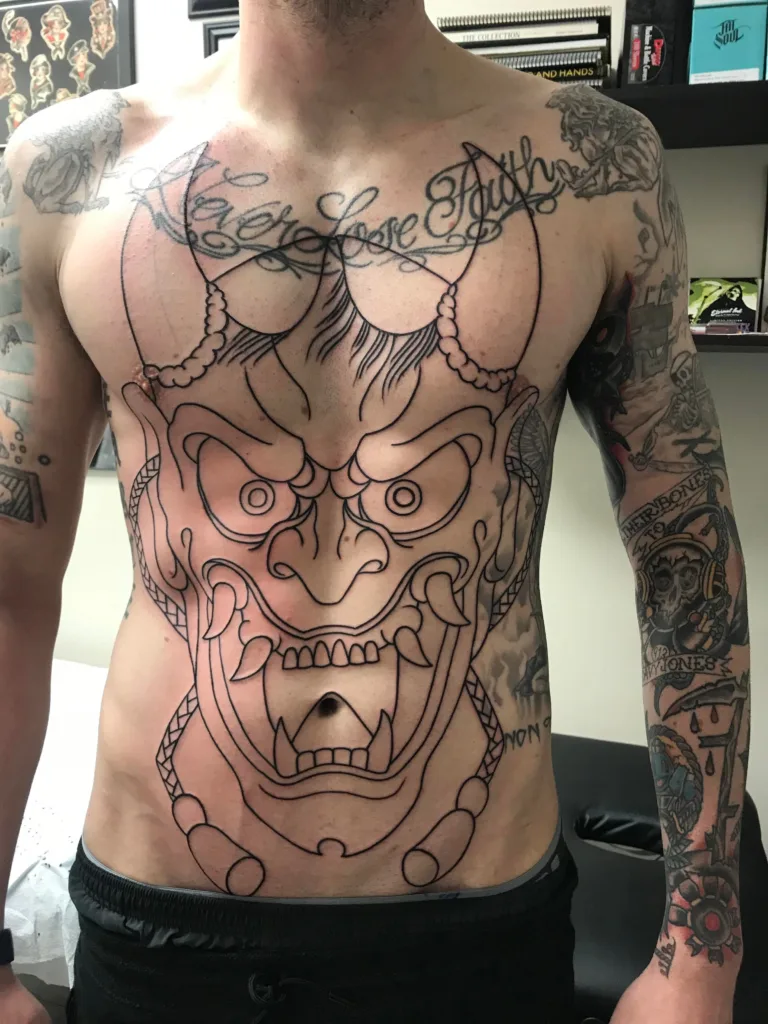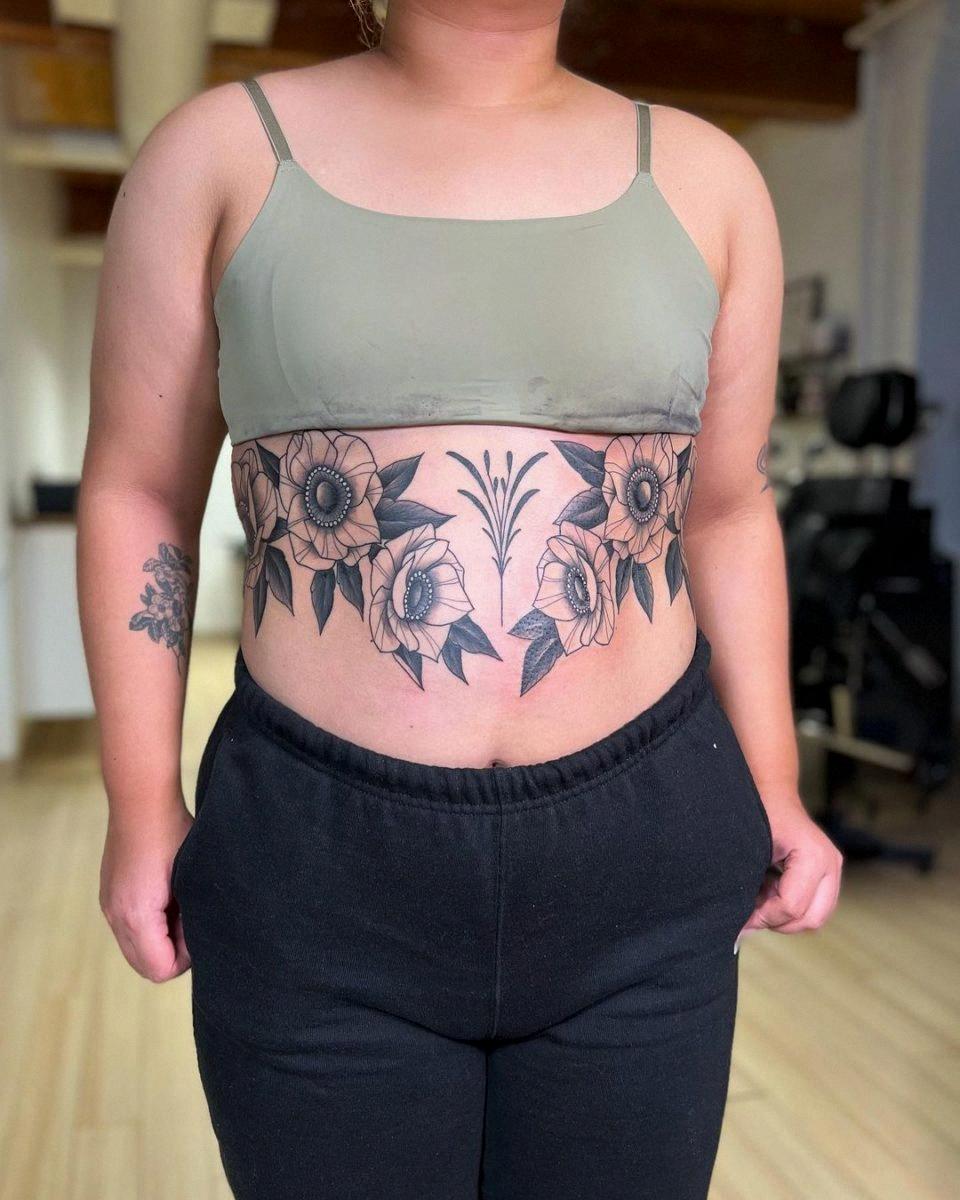Stomach tattoos have become increasingly popular in recent years, particularly among women. While the stomach may be an attractive spot for a tattoo, many people wonder if getting a stomach tattoo will be more painful than other areas of the body. In this post, we’ll explore the question of whether stomach tattoos hurt and offer some tips to help reduce the pain if you do decide to go ahead with one.
Firstly, it’s important to note that everyone’s pain tolerance is different, so what one person finds painful, another may not. However, generally speaking, stomach tattoos can be quite painful. The stomach area is home to a lot of nerve endings and has relatively thin skin, which can make the tattooing process more uncomfortable than other areas of the body.
That being said, there are a few things you can do to help reduce the pain when getting a stomach tattoo. Here are some tips:
1. Choose a licensed tattoo artist: This may seem obvious, but it’s important to choose a licensed and experienced tattoo artist. A skilled artist will know how to make the process as painless as possible and will be able to work quickly and efficiently.
2. Pick a less sensitive body part: If you’re really worried about the pain, consider getting your tattoo on a less sensitive body part, such as your outer shoulder, calf, buttocks, or outer arm.
3. Get enough sleep: Make sure you’re well-rested before your appointment. Being tired can make the pain feel more intense.
4. Avoid pain relievers: Contrary to popular belief, taking pain relievers before your appointment can actally make the pain worse. Pain relievers thin your blood, which can lead to more bleeding and swelling during the tattooing process.
5. Don’t get a tattoo when you’re sick: If you’re feeling under the weather, it’s best to reschedule your appointment. Being sick can make the pain feel more intense, and it can also make the healing process more difficult.
6. Stay hydrated: Make sure you drink plenty of water before and during your appointment. Dehydration can make the pain feel more intense.
7. Eat a meal: Make sure you eat a meal before your appointment. Getting a tattoo on an empty stomach can lead to lightheadedness and nausea, which can make the pain feel worse.
8. Avoid alcohol: Drinking alcohol before your appointment can thin your blood and make the pain feel more intense. It’s best to avoid alcohol for at least 24 hours before your appointment.
Stomach tattoos can be quite painful due to the high concentration of nerve endings in the area. However, there are a few things you can do to help make the process more bearable. By following these tips, you can reduce the pain and discomfort associated with getting a stomach tattoo.
Reducing Pain During a Stomach Tattoo
Getting a stomach tattoo can be a painful experience, but there are several things you can do to minimize the pain. Firstly, it is important to choose a licensed tattoo artist who is experienced and skilled in their craft. This will ensure that the process is done correctly and efficiently, which can reduce the amount of time you spend in discomfort.
Another way to reduce the pain is by selecting a less sensitive area of the stomach for the tattoo. The skin around the belly button is generally more sensitive and therefore can cause more pain. Opting for a location with less nerve endings, such as the lower or upper stomach, may help to reduce the pain.
Getting enough sleep before your appointment is also crucial. Being well-rested can help to reduce anxiety, which can increase pain sensitivity. Additionally, it is important to avoid pain relievers such as aspirin or ibuprofen before the appointment as they can thin the blood and cause excessive bleeding durig the process.
It is also important to avoid getting a tattoo when you are sick or feeling unwell, as your body may be more sensitive to pain during this time. Staying hydrated, eating a meal before the appointment, and avoiding alcohol can also help to reduce the pain associated with getting a stomach tattoo.
Overall, while getting a stomach tattoo is not entirely painless, taking these steps can help to minimize the discomfort and make the experience more bearable.

Exploring the Pros and Cons of Getting a Stomach Tattoo
Stomach tattoos can be a great idea for many reasons. First and foremost, they offer a lot of space to work with and can be a great way to add a unique and interesting design to your body. Additionally, stomach tattoos can be a great way to cover up any scars or stretch marks that you may have in that area, providing a boost to your confidence and self-esteem.
While the stomach is generally considered to be a painful area to get tattooed, the pain level can vary depending on a variety of factors, including your pain tolerance and the size and complexity of the design. It’s important to choose a skilled and experienced tattoo artist who can work with you to minimize any discomfort and ensure that your tattoo turns out eactly as you envision it.
Overall, if you’re looking for a bold and eye-catching tattoo that can help you feel more confident and comfortable in your own skin, a stomach tattoo may be a great choice for you. Just be sure to do your research and choose a reputable artist who can help bring your vision to life.
The Most Painful Body Part to Tattoo
The most painful body part to tattoo is a subjective matter that can vary from person to person. However, there are some areas of the body that are known to be more painful than others due to the presence of nerve endings, thin skin, and bone proximity. The armpit is widely considered the most painful spot to tattoo due to the high concentration of nerve endings in the area. Other notoriously painful areas include the rib cage and stomach, collarbone, elbows, knees, shins, ankles, feet, and the middle of the chest. These areas have thin skin and proximity to bone, which can heighten the sensation of pain during the tattooing process. It’s important to keep in mind that everyone’s pain tolerance is different, and what may be unbearable for one person may be tolerable for another. Ultimately, the level of pain experienced during a tattoo will depend on various factors such as the individual’s pain threshold, the size and complexity of the design, and the skill of the tattoo artist.
The Least Painful Place to Get a Tattoo
The least painful places to get a tattoo are areas of your body with fewer nerve endings. These areas include the outer shoulder, calf, buttocks, and outer arm. Generally, the location of the tattoo on the body plays a crucial role in determining the level of pain felt duing the tattooing process. However, according to Stanley Kovak, a cosmetic physician, pain is more about size than location. The larger the tattoo, the more pain you are likely to experience. Therefore, if you’re looking for a less painful tattoo experience, it’s best to choose a smaller design or break up a larger design into smaller sessions.
The Pain of Stomach Tattoos for Skinny People
Stomach tattoos can be painful for people of any body type, including those who are skinny. In fact, people with very low body fat may actually feel more pain dring the tattooing process due to the lack of cushioning and protection for the nerves and bones beneath the skin. Additionally, since the skin on the stomach is typically thin and sensitive, it may be more prone to pain and discomfort during the tattooing process. However, it’s important to note that pain tolerance can vary widely among individuals, and some people may find that the pain of a stomach tattoo is manageable or even minimal. Ultimately, if you’re considering getting a stomach tattoo, it’s important to carefully consider your own pain tolerance and to work with a skilled and experienced tattoo artist who can help minimize discomfort and ensure a successful outcome.

The Pain of Getting a Stomach Tattoo
Getting a tattoo on the stomach can be a painful experience, but the level of pain can vary from person to person depending on factors such as their pain tolerance, the size and design of the tattoo, and the location on the stomach where the tattoo is being done. Generally, the stomach tends to have more cushioning in the form of fat or muscle than many other body parts, which can help to reduce the intensity of the pain. Additionally, there are no bones in the stomach area, which also makes it a less painful place to get a tattoo. However, the skin on the stomach is still quite sensitive, and some people may experience discomfort or pain during the tattooing process. On a scale of 1 to 10, with 10 being the most painful, most people would rate the pain of a stomach tattoo around a 6. It’s important to remember that pain is subjective and can vary greatly from person to person, so it’s always a good idea to talk to your tattoo artist about any concerns you have and to take steps to minimize pain during the tattooing process, such as taking breaks or usng numbing cream.
What to Wear for a Stomach Tattoo
When getting a stomach tattoo, it is important to wear comfortable clothing that allows easy access to the area being tattooed. It is recommended to wear a bottom with an elastic waist, as it can be adjusted to accommodate the tattoo artist’s needs. Alternatively, wearing low-cut jeans can work, but it is essential to wear underwear that you are comfortable showing. If you are concerned about privacy, wearing a bathing suit bottom can be a great option. Additionally, it is best to avoid tight-fitting clothing as it can case discomfort during the tattooing process. Overall, wearing loose-fitting and comfortable clothing is the best choice when getting a stomach tattoo.
Should I Eat Before Getting a Stomach Tattoo?
Yes, it is recommended that you eat before getting a stomach tattoo. Tattoo artists suggest eating one to two hours before your appointment, and a meal that is high in protein and vegetables is a good choice. This type of meal provides your body with the necessary nutrients and energy to help you tolerate the pain of the tattooing process. Additionally, a healthy meal is less likely to caue discomfort or nausea during the procedure. It’s important to avoid consuming alcohol or drugs before your tattoo appointment, as they can make you more sensitive to pain and increase the risk of bleeding. In summary, eating a healthy meal before a stomach tattoo can help make the experience more tolerable and reduce the likelihood of discomfort or complications.
Healing Time for a Stomach Tattoo
A stomach tattoo usually takes about 2 to 3 weeks to heal the outer layer of skin. However, complete healing of the skin under the tattoo can take as long as 6 months. During this time, it is important to take proper care of the tattoo to avoid any potential infections or complications. You should avoid scratching or picking at the tattoo, keep it clean and dry, avoid exposure to direct sunlight, and avoid wearing tight clothing around the area. By following these aftercare instructions, you can ensure that your stomach tattoo heals properly and looks its best for years to come.

Source: mamasuncut.com
What Is the Most Tolerable Tattoo Pain?
When it comes to tattoo pain management, there is no one-size-fits-all solution. The level of pain experienced during a tattooing procedure can vary greatly depending on the individual’s pain tolerance, the location of the tattoo, and the size and complexity of the design. However, there are several pain management options that can help make the tattooing process more comfortable.
One of the most common ways to manage tattoo pain is to use over-the-counter pain relievers, such as acetaminophen or ibuprofen. These medications can help alleviate pain and swelling during and after the tattooing procedure. However, it is important to follow the recommended dosage and consult with a healthcare provider if you have any medical conditions or are taking other medications.
Another option is to use topical skin-numbing products, such as lidocaine cream or spray. These products work by numbing the skin’s surface, making the tattooing process more comfortable. However, it is important to follow the product’s instructions carefully and not overapply, as this can lead to adverse effects.
In addition to thse options, some tattoo artists may also use a technique called “numbing gel” or “freezing gel.” This involves applying a gel or cream to the skin before the tattooing procedure, which helps to temporarily numb the area.
Ultimately, the best tattoo pain management option will depend on the individual’s preferences and pain tolerance. It is important to discuss any concerns with the tattoo artist beforehand and to follow proper aftercare instructions to minimize discomfort and promote healing.
The Effectiveness of Numbing Cream for Tattoos
Yes, numbing creams do work for tattoos. These creams work by numbing the skin’s surface, which helps to reduce the pain and discomfort associated with getting a tattoo. They are a popular choice among people who have a low pain tolerance or are getting a particularly large or intricate tattoo.
There are several over-the-counter numbing creams available, and they typically contain lidocaine or prilocaine as the active ingredient. These compounds work by blocking the pain signals that are sent to the brain, which can significantly reduce the amount of pain felt during the tattooing process.
It’s important to note that numbing creams sould be used according to the instructions provided by the manufacturer or a healthcare professional. Overuse or misuse of these creams can lead to complications, such as skin irritation or allergic reactions. Additionally, it’s essential to choose a reputable brand and to ensure that the product is safe for use on tattoos specifically.
In summary, numbing creams are a safe and effective way to reduce the pain associated with getting a tattoo. However, it’s crucial to use them correctly and to choose a reputable product to avoid any potential complications.
Using Numbing Cream Before a Tattoo
Yes, you can use numbing cream before getting a tattoo. Numbing cream is a topical anesthetic that helps to reduce the pain and discomfort associated with getting a tattoo. It is especialy helpful for people who have a low pain tolerance or are getting their first tattoo.
To use numbing cream before a tattoo, you should apply it to the area where you will be getting tattooed about 30-40 minutes before your appointment. It is important to follow the instructions provided with the cream and to not exceed the recommended dose.
It is also important to note that while numbing cream can help to reduce the pain of getting a tattoo, it does not completely eliminate it. Some discomfort may still be present, especially in sensitive areas. It is always best to talk to your tattoo artist about any concerns you may have and to follow their aftercare instructions to ensure proper healing.
How Much Should I Tip My Tattoo Artist?
When it comes to tipping a tattoo artist, there is no hard and fast rule. However, it is generally recommended to tip between 20% to 25% of the total cost of the tattoo. In some cases, the artist may have a set tip amount or percentage that they prefer, so it’s always a good idea to ask them directly. If you are on a tight budget, a minimum of 15% is stll considered acceptable. It’s important to keep in mind that tattoo artists work hard to create a piece of art that will last a lifetime. Tipping is a way to show appreciation for their talent and hard work, as well as to build a positive relationship with the artist for future work. Ultimately, the amount you tip is up to your discretion, and it’s always a good idea to base it on the quality of the work and the level of service provided by the artist.

Source: thetrendspotter.net
The Sensation of Tattoo Pain
Tattoo pain can differ from person to person, but generally, it is described as a pricking or scratching sensation that can feel like being repeatedly poked with a needle. As the needle penetrates deeper layers of skin, the pain may intensify and feel like a more painful vibration. Pain can also vary depending on the location of the tattoo. Areas with more nerve endings, such as the fingers or rib cage, may cuse more intense pain than areas with fewer nerve endings, such as the upper arm or thigh. It’s important to note that everyone’s pain tolerance is different, so what may be painful for one person may not be for another.
The Reasons Why Tattoo Artists Do Not Use Numbing Cream
There are several reasons why some tattoo artists choose not to use numbing cream during the tattooing process. Firstly, numbing creams can affect the quality of the tattoo, as they may cause the skin to become swollen or distorted, making it harder for the artist to create clean and precise lines. Additionally, numbing creams can also make the skin feel harder and less pliable, which can make it harder for the artist to work with.
Furthermore, some artists belive that the pain of getting a tattoo is an important part of the experience and should not be dulled. They argue that the discomfort of the process can help clients appreciate the artistry and craft of tattooing more fully. Additionally, some clients may be more motivated to take proper care of their tattoo after experiencing the pain of getting it done.
Finally, there are also some safety concerns associated with using numbing cream during tattooing. For example, if the cream is not applied properly or if the client has an allergic reaction to it, it can cause serious health problems. For these reasons, some tattoo artists prefer to rely on other methods of pain management, such as distraction techniques or taking breaks during the tattooing process.
Conclusion
In conclusion, gtting a tattoo on your stomach can be a painful experience, but there are ways to minimize the discomfort. Choosing a licensed tattoo artist, getting enough sleep, avoiding pain relievers, staying hydrated, and eating a meal before your appointment can all help reduce the pain. Additionally, selecting a less sensitive body part, such as the outer shoulder or calf, may also be a good option to consider if pain is a concern. Ultimately, the level of pain experienced during a stomach tattoo will vary from person to person, but with proper preparation and care, the discomfort can be managed.
